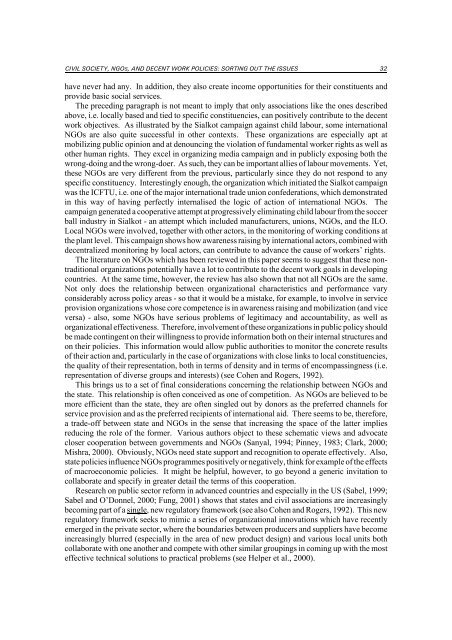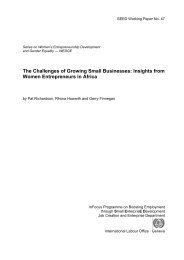Civil Society, NGOs, and Decent Work Policies: Sorting out the Issues
Civil Society, NGOs, and Decent Work Policies: Sorting out the Issues
Civil Society, NGOs, and Decent Work Policies: Sorting out the Issues
Create successful ePaper yourself
Turn your PDF publications into a flip-book with our unique Google optimized e-Paper software.
CIVIL SOCIETY, NGOS, AND DECENT WORK POLICIES: SORTING OUT THE ISSUES 32<br />
have never had any. In addition, <strong>the</strong>y also create income opportunities for <strong>the</strong>ir constituents <strong>and</strong><br />
provide basic social services.<br />
The preceding paragraph is not meant to imply that only associations like <strong>the</strong> ones described<br />
above, i.e. locally based <strong>and</strong> tied to specific constituencies, can positively contribute to <strong>the</strong> decent<br />
work objectives. As illustrated by <strong>the</strong> Sialkot campaign against child labour, some international<br />
<strong>NGOs</strong> are also quite successful in o<strong>the</strong>r contexts. These organizations are especially apt at<br />
mobilizing public opinion <strong>and</strong> at denouncing <strong>the</strong> violation of fundamental worker rights as well as<br />
o<strong>the</strong>r human rights. They excel in organizing media campaign <strong>and</strong> in publicly exposing both <strong>the</strong><br />
wrong-doing <strong>and</strong> <strong>the</strong> wrong-doer. As such, <strong>the</strong>y can be important allies of labour movements. Yet,<br />
<strong>the</strong>se <strong>NGOs</strong> are very different from <strong>the</strong> previous, particularly since <strong>the</strong>y do not respond to any<br />
specific constituency. Interestingly enough, <strong>the</strong> organization which initiated <strong>the</strong> Sialkot campaign<br />
was <strong>the</strong> ICFTU, i.e. one of <strong>the</strong> major international trade union confederations, which demonstrated<br />
in this way of having perfectly internalised <strong>the</strong> logic of action of international <strong>NGOs</strong>. The<br />
campaign generated a cooperative attempt at progressively eliminating child labour from <strong>the</strong> soccer<br />
ball industry in Sialkot - an attempt which included manufacturers, unions, <strong>NGOs</strong>, <strong>and</strong> <strong>the</strong> ILO.<br />
Local <strong>NGOs</strong> were involved, toge<strong>the</strong>r with o<strong>the</strong>r actors, in <strong>the</strong> monitoring of working conditions at<br />
<strong>the</strong> plant level. This campaign shows how awareness raising by international actors, combined with<br />
decentralized monitoring by local actors, can contribute to advance <strong>the</strong> cause of workers’ rights.<br />
The literature on <strong>NGOs</strong> which has been reviewed in this paper seems to suggest that <strong>the</strong>se nontraditional<br />
organizations potentially have a lot to contribute to <strong>the</strong> decent work goals in developing<br />
countries. At <strong>the</strong> same time, however, <strong>the</strong> review has also shown that not all <strong>NGOs</strong> are <strong>the</strong> same.<br />
Not only does <strong>the</strong> relationship between organizational characteristics <strong>and</strong> performance vary<br />
considerably across policy areas - so that it would be a mistake, for example, to involve in service<br />
provision organizations whose core competence is in awareness raising <strong>and</strong> mobilization (<strong>and</strong> vice<br />
versa) - also, some <strong>NGOs</strong> have serious problems of legitimacy <strong>and</strong> accountability, as well as<br />
organizational effectiveness. Therefore, involvement of <strong>the</strong>se organizations in public policy should<br />
be made contingent on <strong>the</strong>ir willingness to provide information both on <strong>the</strong>ir internal structures <strong>and</strong><br />
on <strong>the</strong>ir policies. This information would allow public authorities to monitor <strong>the</strong> concrete results<br />
of <strong>the</strong>ir action <strong>and</strong>, particularly in <strong>the</strong> case of organizations with close links to local constituencies,<br />
<strong>the</strong> quality of <strong>the</strong>ir representation, both in terms of density <strong>and</strong> in terms of encompassingness (i.e.<br />
representation of diverse groups <strong>and</strong> interests) (see Cohen <strong>and</strong> Rogers, 1992).<br />
This brings us to a set of final considerations concerning <strong>the</strong> relationship between <strong>NGOs</strong> <strong>and</strong><br />
<strong>the</strong> state. This relationship is often conceived as one of competition. As <strong>NGOs</strong> are believed to be<br />
more efficient than <strong>the</strong> state, <strong>the</strong>y are often singled <strong>out</strong> by donors as <strong>the</strong> preferred channels for<br />
service provision <strong>and</strong> as <strong>the</strong> preferred recipients of international aid. There seems to be, <strong>the</strong>refore,<br />
a trade-off between state <strong>and</strong> <strong>NGOs</strong> in <strong>the</strong> sense that increasing <strong>the</strong> space of <strong>the</strong> latter implies<br />
reducing <strong>the</strong> role of <strong>the</strong> former. Various authors object to <strong>the</strong>se schematic views <strong>and</strong> advocate<br />
closer cooperation between governments <strong>and</strong> <strong>NGOs</strong> (Sanyal, 1994; Pinney, 1983; Clark, 2000;<br />
Mishra, 2000). Obviously, <strong>NGOs</strong> need state support <strong>and</strong> recognition to operate effectively. Also,<br />
state policies influence <strong>NGOs</strong> programmes positively or negatively, think for example of <strong>the</strong> effects<br />
of macroeconomic policies. It might be helpful, however, to go beyond a generic invitation to<br />
collaborate <strong>and</strong> specify in greater detail <strong>the</strong> terms of this cooperation.<br />
Research on public sector reform in advanced countries <strong>and</strong> especially in <strong>the</strong> US (Sabel, 1999;<br />
Sabel <strong>and</strong> O’Donnel, 2000; Fung, 2001) shows that states <strong>and</strong> civil associations are increasingly<br />
becoming part of a single, new regulatory framework (see also Cohen <strong>and</strong> Rogers, 1992). This new<br />
regulatory framework seeks to mimic a series of organizational innovations which have recently<br />
emerged in <strong>the</strong> private sector, where <strong>the</strong> boundaries between producers <strong>and</strong> suppliers have become<br />
increasingly blurred (especially in <strong>the</strong> area of new product design) <strong>and</strong> various local units both<br />
collaborate with one ano<strong>the</strong>r <strong>and</strong> compete with o<strong>the</strong>r similar groupings in coming up with <strong>the</strong> most<br />
effective technical solutions to practical problems (see Helper et al., 2000).
















